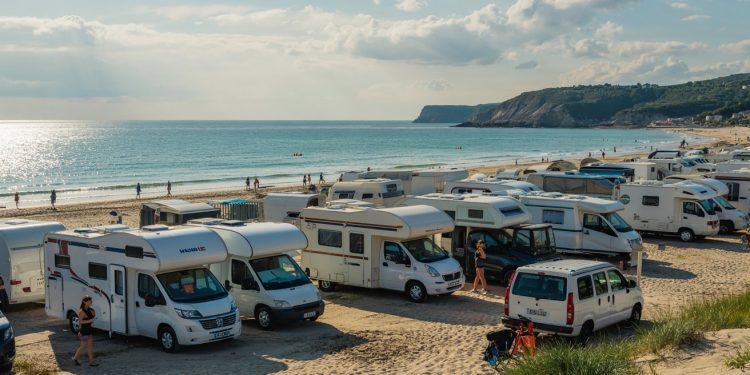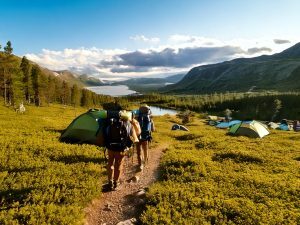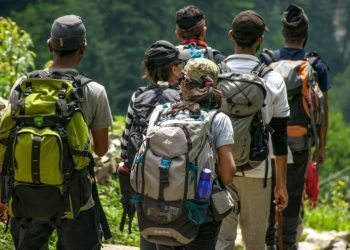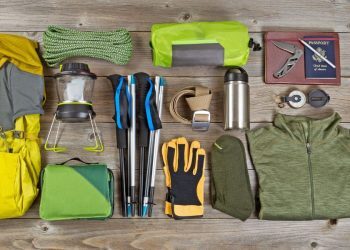Self-catering tourism – which includes, for example, campervan tourism, cottage accommodation and hiking where visitors bring their own tents and food – has become increasingly popular in Sweden. The number of registered motorhomes has risen sharply over the past decade, and interest in outdoor recreation and ‘home stays’ (svemester) has led more people to holiday in cabins or go hiking. This form of tourism means that travellers are largely self-sufficient in terms of accommodation and food. This creates unique opportunities for people to experience nature on their own terms, but it also poses particular challenges for the local communities and destinations that host these visitors.
Here we map how self-sufficient tourism affects the local economy in Swedish rural areas, focusing on how much these tourists consume locally and what pressures arise for services, infrastructure and hosting. This is followed by examples – both from Sweden and internationally – of how destinations are trying to meet the challenges. Finally, there is a summary reflection on which solutions seem most sustainable to ensure local benefits and long-term development.
Local consumption and challenges
Limited local consumption
A general observation is that self-sufficient tourists tend to spend relatively little money locally compared to other visitors. As they bring their own accommodation (motorhome, tent or cabin) and often their own food, the need to use local commercial services such as hotels and restaurants is reduced. Motor caravanning tourists often cook in their motorhome and can stay for free in a car park instead of paying for a campsite or hotel. Similarly, hikers with tents buy many of their provisions in advance, avoiding costs along the trail, and holidaymakers typically cook their own meals in their cabins.
Several sources suggest that consumption by these groups is limited. A Norwegian industry study suggests that for every krone spent at a campsite, 3-5 kroner are generated in the surrounding economy bobilverden.no. This indicates that when motorhome tourists choose fricamping (free parking outside campsites), there is no significant local additional turnover – not only the camping fee, but also secondary spending on, for example, restaurant visits, attractions or shop purchases is reduced. A camper who only stays overnight for free and cooks all the food himself thus contributes very little economically locally; some local residents even have the opinion that if camper tourists only shop minimally locally and look after themselves, their contribution will be ‘almost negligible’ for the locality natverkethallbarbesoksnaring.se.
However, it should be emphasised that self-sufficient tourists are not entirely without local consumption. Groceries and supplies often need to be replenished during the journey. A study from Jämtland shows that local rural shops in sparsely populated areas are largely kept alive by tourists and holidaymakers: ‘It is the tourists and Norwegians who shop here, not the locals’ noted a trader in a village, as residents often shop more cheaply on a weekly basis in larger urban centres. Campers and holiday makers in particular want a well-stocked local grocery store to buy what they need during their stay. Visitors are often willing to pay a little more at the small shop for convenience, which can offset the higher costs of the shop. In destinations close to the Norwegian border, local grocery stores have even adapted their assortment to cater for Norwegian tourists, who form a large customer base jht.se.
Many self-sufficient tourists spend money on fuel, groceries and some retail (e.g. outdoor equipment, souvenirs) in the local area, but they spend significantly less on commercial accommodation, restaurants and guided activities than the average tourist. In Fulufjället National Park, for example, only around 5-8 % of visitors reported spending money on any activity during their visit, while a majority bought food. This consumption pattern means that the direct tourist turnover in the local community per person is lower, which affects how much economic benefit the locality can derive from increased visitor numbers. Self-sufficient tourists often do not have access to much information and can easily miss that there are, for example, guided tours they could take part in. It is therefore important to try to reach this group in a flexible way.
Pressures on local services and infrastructure
Despite their relatively limited consumption, self-sufficient tourists utilise local infrastructure and natural resources, creating costs and challenges for host communities. Maintenance of trails and natural areas is a key challenge. The increase in walking tourism in Sweden has led to severe wear and tear on many popular trails, resulting in erosion, damage to sensitive environments and reduced accessibility. At the same time, maintenance has not always kept pace – several reports and debates have pointed to a lack of resources to manage the trails. One concrete example is the Höga Kusten trail, which, along with many other trails, has been in need of renovation. In 2024, the outdoor recreation company Naturkompaniet decided to sponsor the renovation of 12 popular hiking trails (including the High Coast) with a total of SEK 3.5 million. This private initiative – called the ‘Nature Bonus’ – emphasises that public maintenance has not been sufficient and that alternative sources of funding are being sought to cover the costs. Regions and municipalities are also trying to provide support; in Västernorrland, the region, municipalities, the County Administrative Board and local stakeholders have been working together since 2021 to develop and maintain the High Coast Trail 7an.se .
Similar needs exist in many places – for example, the state (Swedish Environmental Protection Agency) has recently increased grants for trail development, but then often requires local co-financing of at least 30% naturvardsverket.se. For small municipalities with a limited tax base, this can be difficult to prioritise, especially if the tourism industry does not generate direct revenue for the municipality’s economy.
Waste management and sanitation services are another challenge. Self-sufficient tourists rely on the right of public access to move around and stay overnight in the countryside, but the right of public access does not entail any responsibility to provide facilities. However, many municipalities and landowners find that they need to provide rubbish bins, outhouses, fireplaces, shelters and car parks at popular sites to avoid littering and disturbance. Every summer, there are examples of overflowing bins at picnic areas and car parks used by camper van tourists, or litter along paths used by walkers. In some cases, littering and unauthorised waste disposal have led to strong backlashes. International experience is telling: in New Zealand, municipalities have been forced to ban free camping at certain sites after problems with camping vehicles littering and polluting the environment diva-portal.org. In Sweden, too, there is a clear concern that the right of public access could be threatened if tourists abuse their freedom and do not ‘behave’ natverkethallbarbesoksnaring.se. As one motorhome writer reminds us, the right of public access does not apply to vehicles – motorhomers must comply with local rules of order and traffic regulations, and it is absolutely forbidden to empty latrine or grey water in the countryside husbilskompisar.se. Despite this, offences do occur, creating additional work and costs for landowners and municipal cleaning teams.
Traffic and parking congestion is another aspect. The flip side of the motorhome boom is that many small towns and natural areas have been inundated by large vehicles during the high season. Commuter car parks, beach car parks or roadside coves are filled with overnight motorhomes, in some cases crowding out local residents and causing irritation. In Oskarshamn, for example, commuters complained that motorhomes were staying overnight in a commuter car park and taking up space barometern.se. Several municipalities – Trelleborg, Gotland and others – have had to review where motorhomes are allowed to park and have sometimes introduced stricter parking surveillance and signs during the tourist season. The Swedish Transport Administration and the Swedish Transport Agency have discussed standardised road signs for motorhome parking to help tourist-dense municipalities control the flow of traffic. Constantly having to expand car parks, clean rest areas and repair the wear and tear on roads and trails without bringing in the corresponding revenue is an equation that many rural municipalities struggle with.
Hospitality challenges also arise. Local people’s attitudes towards tourists can be adversely affected if they feel that visitors are ‘taking over the place’ without giving anything back. Motorhome tourists in particular have sometimes gained a reputation for being stingy or inconsiderate, which can erode hospitality. There are examples of locals who have become so fed up with bush toilets and misparked campervans that they have wanted to close off areas completely. At the same time, many people are proud of their neighbourhood and are happy to welcome guests – as long as it is done in a respectful way. The balancing act can be difficult: on the one hand, destinations want to promote their unique natural environments, but on the other hand they need to encourage visitors to take responsibility for preserving these values natverkethallbarbesoksnaring.se.
In some popular areas (e.g. around the High Coast and mountain destinations), they have started to provide clearer information about the ‘dos and don’ts’ of nature and the importance of contributing to the locality. There is also talk of getting tourists to become ‘regenerative ’ rather than exploitative – giving something back. A sustainable tourism group in Sweden described the ideal ‘regenerative campervan tourists ’ as those who shop locally, stay overnight on designated pitches and contribute to local nature conservation projects natverkethallbarbesoksnaring.se. This quote captures both frustration (‘if you’re going to come here, we want something in return’) and the ambition to turn the challenge into an opportunity.
To summarise, rural destinations face the dilemma of managing large visitor flows with small margins. Tourists wear out trails, use car parks, fill up rubbish bins and use rights of way – all of which require management and sometimes regulation. If local consumption by tourists does not offset the costs, local engagement and support for tourism risks declining. Therefore, many destinations have started to look for solutions to increase local benefits and reduce the negative impacts of self-sustainable tourism. Below are various strategies and measures that have been tried or discussed to tackle these challenges.
Solutions and strategies
Stimulating local consumption
One approach is to try to get self-sufficient visitors to spend more money in the resort anyway, through voluntary incentives and smart offerings. Information and marketing can play a role – clearly highlighting to tourists the local shops, farm vendors, cafés and activities available, so that they are attracted by the offer. For example, some tourist resorts have produced leaflets or apps with tips on stocking up the pantry at the local grocery store instead of buying everything at home, or buying fresh vegetables and meat from local farm shops for barbecues at the cottage. During the pandemic’s home stay boom, it was reported that many people discovered local farm shops and craft products while travelling by camper van or staying in a cottage, which then benefited local producers.
A more organised example is the concept of ‘regenerative tourism ’ mentioned in industry conversations. Destinations can encourage motorhome tourists to become ‘regenerative ’ by establishing dedicated pitches close to the town centre where visitors have amenities and easy access to shops and restaurants. This increases the likelihood that they will shop locally rather than park remotely and live entirely self-sufficiently. Some small towns have introduced free day parking for motorhomes next to shopping areas precisely to capitalise on the purchasing power of motorhome tourists (e.g. Nagu in the Finnish archipelago, where the aim is to encourage motorhomers to stay at the village, which has no camping but attracts them with its beautiful surroundings yle.fi).
Others, on the other hand, have opted to charge a small fee for central pitches but include discount vouchers for local restaurants or attractions in the price – a way to steer consumption back to the village.
Events and packages aimed at self-catering tourists can also stimulate local trade. For example, some destinations have organised ‘farmers’ markets ‘ or food festivals at campsites, inviting campers and cottagers to taste and buy local delicacies. The result is that tourists have an experience and spend money on local products, while local businesses gain revenue and the chance to build relationships with visitors. In mountain areas, there have been attempts to offer hiking packages that include accommodation in a hut or simple mountain guesthouse and meals with a local flavour – although the genuinely self-sufficient hiker may decline, a comfortable package with a sauna and game dinner may tempt some hikers to splurge for a night. Such ‘hiking with a difference’ offers are marketed, for example, by Countryside Hotels and the Swedish Tourist Association to reach even those nature tourists who do not normally book traditional hotels (countrysidehotels.se and svenskaturistforeningen.se).
In short, many host cities are trying to get better at capturing the money that is already in circulation. By strategically placing services (pitches, information, markets) and offering things that even the self-sufficient can appreciate (local produce, unique experiences), consumption can increase without coercion. This strengthens the positive link between tourism and the local economy.
Introduction of levies and subsidies
A more direct approach to addressing both costs and lost revenues is to introduce charging schemes linked to self-sufficient tourists. The idea is to allow visitors to pay for the wear and tear and the services they use, which at the same time can provide resources for better infrastructure. Several models have been tried or discussed:
- Parking and accommodation fees: Many municipalities have started to charge for parking at popular nature destinations. A token amount (e.g. £20-50 per day) on a previously free car park can provide a welcome injection of funds earmarked for the upkeep of that particular site (e.g. for the maintenance of toilets, refuse collection or signage). In some nature reserves and national parks such charges have been introduced for car parking. For motorhomes, there are special pitches where you pay per night to stay safely and perhaps have access to fresh water and drainage. Municipalities such as Karlskrona and Högsby have built central car parks with a daily fee and easy payment via Swish hogsby.se. The fees are often lower than a commercial campsite, to be attractive, but still sufficient to cover cleaning and some operations. In this way, it’s a win-win: tourists get an organised place to stay, and the resort gets funds and controls where overnight stays take place.
- Trail passes and conservation fees: A controversial but pioneering initiative in Sweden is the introduction of a voluntary hiking pass in the southern Åre mountains. There, the local trail management company, in consultation with landowners, has chosen to ‘charge’ for some 63 kilometres of private mountain trails by offering hikers to buy an annual pass (price about SEK 2 000) as a contribution to trail management . Since legal coercion is not possible (the right of public access gives the right to walk without paying), the fee is voluntary, but the initiators hope for the goodwill of visitors. The motivation behind this is clear: if nothing is done, the increasing traffic risks destroying nature and ultimately undermining the right of public access
- sverigesradio.se. The trial started in 2022 and the outcome of the first summer was limited – only around SEK 100,000 was raised, indicating that relatively few hikers chose to pay
- jamtlandstidning.se. Critics argue that this is not enough and that the voluntary nature makes it toothless etc.se. Proponents counter that it at least establishes the principle that hikers should also contribute financially. The Södra Årefjällen case has led to a debate on principle: are trails to be equated with ski tracks (where fees are common), and can voluntary payments be a way forward? So far, the outcome is mixed, but other destinations are closely following developments.
- Tourist taxes and visitor fees: Internationally, there are examples of broader charging solutions. New Zealand introduced a general International Visitor Conservation and Tourism Levy in 2019 of around NZ$35 per overseas visitor, levied at the time of visa or arrival, with the revenue earmarked for sustainable tourism and nature conservation mbie.govt.nz. (In 2024, NZ plans to raise this levy to NZ$100 due to increasing visitor pressure reuters.com.)
Similar models exist in Norway, for example, where foreign fishing tourists pay a small amount for fishing licences that goes to local rescue funds and environmental measures. In several European countries, cities charge a ‘tourist tax “ per night in hotels – in Sweden there has been no equivalent for rural/nature tourism, but there have been discussions about, for example, a ”mountain tax “ or ”archipelago tax’. So far, no Swedish municipality has the legal right to unilaterally introduce such a tax, but some destinations have experimented with voluntary contributions. In Jokkmokk, for example, visitors were once encouraged to swap a sum of their choice into a ‘nature conservation account’ for each night they camped at a popular waterfall – a simple system, but one based on honesty and goodwill. Italy’s Cinque Terre is also attracting international attention, with the busiest coastal trails charging for a hiking pass (~€7.5-15 per day depending on the season) to fund maintenance cinqueterre.eu.com. There, the fee has become socially accepted and delivers tangible results in terms of safe, clean paths and emergency services when needed.
Fees do not solve everything, but they can create an economic feedback from tourists to the site. Done right, they can be seen as legitimate – especially if the revenue is clearly channelled back into improvements that benefit visitors (better trails, cleaner picnic areas, nature conservation). Charging for nature experiences in Sweden is a fine balance, but more destinations are considering some form of fee financing to make tourism financially sustainable in the long term.
Packaged services and added value
A third strategy is to develop new services and packages that make it easier for self-sufficient tourists and generate revenue locally. The idea is to identify needs or amenities that even an independent traveller might be willing to pay for, if presented in the right way.
One successful concept has been to offer comfort services for motorhome tourists. Many small municipalities have realised that if they provide a well-equipped latrine and grey water emptying station, perhaps combined with fresh water refilling and some electricity points, motorhomers will be happy to stop and pay a premium. Such multifunctional service points have appeared along major roads and at entrances to tourist areas. They often charge a fee (in cash or via an app) to unlock the latrine, and can also provide information about local attractions and shops. This is seen as a way to capture the free riders – they may sleep for free in the forest, but sooner or later they will need to empty the tank, and it will be done in an organised way for a fee. The municipality or a local entrepreneur runs the facility for a small profit, while reducing the risk of waste being illegally dumped in nature.
Another package is about linking transport and experiences. Hikers walking long trails often struggle with the logistics of starting and finishing points. This is where companies have found a niche: for a fee, you can have your equipment transported, or book shuttle buses back to the starting point. In the mountains, for example, there are package deals where you can hike from point A to B, spend the night in a cabin (or camp outside), and then be picked up by a minibus to take you back to your starting point – for a fee. This gives villages along the trails a chance to sell a service while connecting with walkers. Luggage transport and food deliveries to shelters also exist in a limited form as a paid service in some areas; for example, walkers on the Bohusleden trail can pre-order provisions from a local operator who delivers to a crossroads near the trail, benefiting the local general store.
For hikers there are packages in the form of “starter kits” or experience kits. In the High Coast destination, it is possible to book a hiking package that includes cabin accommodation, maps, and sometimes even a combined kayaking and hiking adventure. The aim is that even those who initially intended to just rent a cabin and fend for themselves will be tempted to buy added value – perhaps a guided tour up Skuleberget mountain or a boat trip in the archipelago, packaged at a discounted price for cabin guests. Several hotels and guesthouses in the countryside have also created “motorhome packages” where motorhome tourists can park on the hotel’s land and, for a package fee, enjoy a spa, dinner and breakfast buffet. One example is Breanäs Hotel in Skåne, which markets a motorhome package with an electric pitch, three-course dinner and access to the hotel’s amenities hogakusten.com.
This is a smart way to integrate the camper into the traditional hospitality industry: they sleep in their own bed but still consume the hotel’s services.
By being creative and responsive to needs, local businesses can thus repackage their offerings to suit the self-catering segment as well. Such solutions can both increase the quality of the visitor’s experience and generate income that stays in the neighbourhood.
Collaboration between stakeholders
A fourth key to success is collaboration – different stakeholders in the destination working together to address challenges and share both costs and benefits. Self-sufficient tourism often cuts across areas of responsibility: the municipality’s infrastructure, the landowner’s land, the entrepreneurs‘ customers and the non-profit organisations’ outdoor facilities. No single actor can solve everything, but sustainable models can be found through co-operation.
A good Swedish example is the collaboration that takes place around the trails in the mountains and other natural areas. In the case of Södra Årefjällen mentioned above, several villages, landowners and companies joined forces and formed Södra Årefjällen Ledförvaltning AB to jointly manage the trails and finance this . Accommodation facilities, activity companies and village associations contribute funds (directly or indirectly) as they all benefit from well-managed trails. The County Administrative Board is responsible for the state-owned trails, but the private trails complete the network and needed a principal – something that was solved through this collaborative organisation. In the High Coast area, as mentioned, there is also an ongoing project where municipalities, the region, the County Administrative Board and associations are working together to develop the trail and the service around it . In many cases, volunteers also contribute: local outdoor associations or tourist-oriented associations take care of shelters, paths and markings, often with small contributions from the municipality or sponsors in return.
Public-private co-operation can also involve municipalities enlisting the help of the business community for funding. Naturkompaniet’s ‘Nature Bonus’, which provided 3.5 million for trails across Sweden, is an example of businesses stepping in to take responsibility .
At local level, forestry companies or energy companies operating in the area can sponsor rest areas or information signs as compensation for their land use. For their part, tourism operators can get involved in municipal planning to point out where new pitches should be built or which trails should be prioritised for renovation. Dialogue can help avoid misunderstandings – for example, the municipality closing a popular car park for motorhomes without offering alternatives, which otherwise risks backfiring on both visitors and businesses.
Co-hosting initiatives have also proved valuable. Some destinations have introduced the concept of tourist or nature hosts during the high season: staff (sometimes volunteers or summer workers) who move around the trails or pitches, welcoming visitors, informing them about rules and giving tips on what to do locally. This has been used successfully overseas – New Zealand, for example, funded ‘Camping Ambassadors’ who visited popular free camping sites and talked to travellers about how to dispose of waste and respect the local community. In Sweden, the Swedish Environmental Protection Agency and county administrative boards have piloted hosts in national parks such as Fulufjället and Abisko, who ensure both the well-being of tourists and compliance with rules. Such hosts can also discreetly encourage local consumption (‘When you come down from the mountain, don’t forget to visit the village café – they have great cinnamon buns!’). To finance hosting, the municipality, local businesses (which can sponsor food/lodging for the hosts) and non-profit organisations such as STF often work together. Although the impact is difficult to measure, this soft collaboration helps to integrate tourists into the local community in a positive way.
Finally, co-operation is also about sharing knowledge and learning from good practices. Through networks such as the Sustainable Tourism Network in Sweden, destinations meet and exchange ideas on how to deal with, for example, over-tourism and outdoor pressure . There are also international collaborations, for example in the Nordic countries, where joint solutions for sustainable nature tourism are being looked at. This knowledge sharing means that successful initiatives can be spread and scaled up in more areas.
Summarising reflections
Self-sustainable tourism challenges the traditional models of how tourism should benefit a community. When visitors do not automatically spend money on accommodation and food, more creativity is needed to ensure local benefit. The mapping shows that while these tourists consume less locally than average, they can still play an important role for the local community – for example, by boosting the turnover of services such as the general store, petrol station and other basic functions that residents also benefit from during the high season. The challenge is to manage the imbalance that can arise when tourists’ wear and tear on nature and infrastructure is not matched by direct revenue to the host town.
The solutions go in two main directions: increasing the revenue from these tourists and improving the efficiency of resource management through co-operation. Increasing revenue does not necessarily mean commercialising the right of way or imposing high fees on visitors. The case of the voluntary trail fee in Årefjällen shows that coercion is not possible and voluntarism difficult, but also that there is a willingness to pay on the part of at least some when they understand the purpose jamtlandstidning.se. In the long term, perhaps a culture can be established where it is seen as natural to make a contribution to the preservation of the nature one enjoys – in the same way that many mountain hikers today pay for winter trails without complaining. International examples such as the Cinque Terre walking pass and the New Zealand tourist levy suggest that if the funds are clearly used to care for the destinations, then charges are accepted by most people.
At the same time, much can be done without having to ‘tax’ tourists, by managing behaviour and supply. Sustainable place development here is about integrating tourists into the local cycle: making it easier for them to do the right thing (dispose of rubbish, park legally, stay overnight safely), and showcasing what is genuinely local so that they choose to consume things that benefit the place. The strategies and examples presented – from car parks in town centres and local markets, to campervan packages in hotels and joint trail management – demonstrate the capacity for innovation in rural destinations. Many of the actions are relatively new, so further evaluation of results is needed. Some initiatives have already had a tangible impact: the Nature Company’s trail upgrades are improving for all parties 7an.se, and the introduction of more pitches in several municipalities has reduced conflicts over misparked motorhomes yle.fi. Others have a more long-term impact, such as building partnerships and gradually changing the culture of both visitors and hosts.
One reflection is that sustainability is a common thread: the models that seem most promising are those that simultaneously promote environmental sustainability and local social sustainability. For example, directing motorhome tourists to fewer but well-equipped sites concentrates and manages environmental impacts, while these sites can act as meeting points between tourists and locals (e.g. via their proximity to a local business). As tourists get to know the local community, they are more likely to feel a sense of responsibility for the place – and may return in the future with a positive attitude.
In conclusion, self-sufficient tourism is neither a blessing nor a curse for rural areas, but something in between which, with the right measures, can be balanced in favour of the positive. It requires innovative business models and sometimes bold decisions (such as testing fees or new partnerships), but the potential exists to turn these visitors into an asset. A lot of knowledge has already been generated through the trials and projects underway in Sweden and abroad. By sharing good examples and adapting them to local conditions, destinations can strengthen sustainability, local benefits and the long-term development of the place – so that tourists, residents and nature itself are winners in the long run.

 STS
STS








